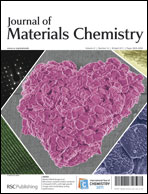Electrical conductivity switching and memory effects in poly(N-vinylcarbazole) derivatives with pendant azobenzenechromophores and terminal electron acceptor moieties†
Abstract
Bistable electrical conductivity switching and non-volatile memory effects were demonstrated in Al/


 Please wait while we load your content...
Please wait while we load your content...